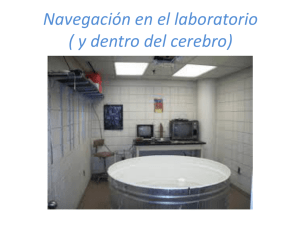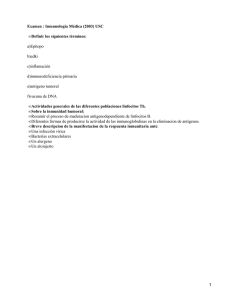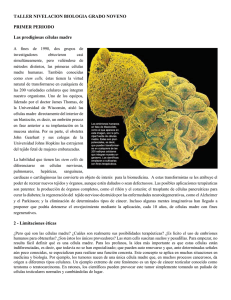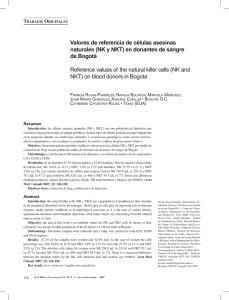CLASE10.08.2010
Anuncio
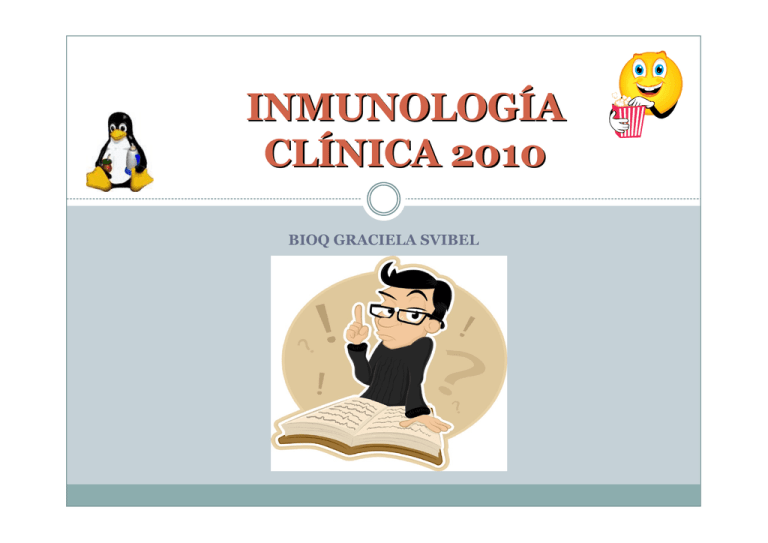
INMUNOLOGÍA CLÍNICA 2010 BIOQ GRACIELA SVIBEL CÉLULAS “NATURAL KILLER” LINFOCITOS GRANDES GRANULARES CAPACES DE PRODUCIR CITOQUINAS INFLAMATORIAS Y DESTRUIR CÉLULAS TUMORALES, ESTRESADAS O INFECTADAS……. ONTOGENIA DE CÉLULAS NK early lymphoid precursors (ELPs). EL DESARROLLO DE CÉLULAS NK DEPENDE DE IL-15 crítica Las cé células CD56bright maduran a CD56dim en los GL por señ señales inducidas por las DCs Localización de las células NK ~5-20% de los linfocitos de sangre periférica ~5% linfocitos en el bazo Abundantes en el hígado Baja frecuencia en el timo, médula ósea, nódulos linfáticos y linfáticos no infectados >90% de los linfocitos en el tejido decidual ¿Qué papel cumplen las células NK? • Defensa frente a bacterias y parásitos • • • intracelulares Control de infecciones virales Eliminación de células tumorales Determinación del perfil de respuesta adaptativa que se montará contra un determinado patógeno CD56bright CD16dim Una Una población población heterogénea!!!!!!! heterogénea!!!!!!! FENOTIPOS FENOTIPOS CD56dim CD16bright TRÁFICO Y MIGRACIÓN CD56bright CD16dim CD56dim CD16bright CD62L+,CCR7+: TRÁFICO A OLS CROSS TALK CON LINFOCITOS T Y CD SECRECIÓN DE INF-γ: ¿SHIFT A Th1? CD62L-,CCR7-: NO INGRESAN A OLS REPRESENTA EL 90% DE CÉLULAS NK EN SANGRE PERIFERICA Citoquinas que regulan la actividad de las células NK IL-2 Estimula citotoxicidad, proliferación y producción de citoquinas IL-12 Estimula citotoxicidad, proliferación y producción de citoquinas IL-15 Estimula citotoxicidad, proliferación y producción de citoquinas Estimula citotoxicidad IFN-γ IFN-α/β β Estimula citotoxicidad IL-10 Inhibe producción de citoquinas Citoquinas secretadas por células NK IFN-γ TNF Inducción respuesta Th1. Activación de monocitos y macrófagos Mediador de la respuesta inflamatoria. Activa monocito y LT. Acción lítica GM-CSF Factor estimulante de colonias de granulocitos/macrófagos TGF-β IL-3 IL-10 Inmunosupresión Induce proliferación y diferenciación de precursores hematopoyéticos Inmunosupresión NK DC RECEPTORES DE CÉLULAS NK EN CONDICIONES NORMALES, EXISTE EQUILIBRIO ENTRE RECEPTORES ACTIVADORES E INHIBIDORES…… LA INDUCCIÓN DE LA MAYORÍA DE LAS FUNCIONES EFECTORAS DE LA CÉLULA NK REQUIEREN EL CONTACTO CÉLULA-CÉLULA…. RECEPTORES INHIBIDORES EXPRESADOS POR CÉLULAS NK Figure 3-23 Estas moléculas son importantes en la presentación de antígenos a linfocitos TCD8+ Estas moléculas son importantes ligandos inhibidores de células NK INHIBICIÓN DE LA FUNCIÓN NK… RECEPTORES ACTIVADORES EXPRESADOS POR CÉLULAS NK LAS CÉLULAS NK PUEDEN ACTUAR A NIVEL PERIFERICO Y EN EL GANGLIO LINFÁTICO Funciones citotóxicas Actividad NK (Natural Killer) Citotoxicidad espontánea. Se mide frente a células diana sensibles que carecen de expresión de moléculas de histocompatibilidad Actividad LAK (Lymphokine Activated Killer) Citotoxicidad inducida por citocinas (IL-2, IFNα α) frente a células diana NK resistentes Actividad ADCC (Antibody dependent cell cytotoxicity) Citotoxicidad dependiente de anticuerpos mediada por receptor FcγIIIb (CD16) Se mide en presencia de anticuerpos unidos a un antígeno en la superficie de la célula diana CITOTOXICIDAD NATURAL NK CD16 BRIGHT CD56 EN ACCIÓN.. NK LOW CITOTOXICIDAD NATURAL: VÍA PERFORINAGRANZIMA B Nature Reviews Immunology 6, 940-952 (December 2006) ¿QUÉ OCURRE SI LA SINAPSIS INMUNOLÓGICA LÍTICA ENTRE LA CÉLULA NK Y EL TARGET NO ES ADECUADA…… LINFOHISTIOCITOSIS HEMOFAGOCÍTICA (HLH)… CÉLULAS NK Y ADCC CÉLULAS NK E INFECCIÓN….. NK Y TUMORES… NK EN TERAPEÚTICA……….. FUNCIONES DE LAS CÉLULAS NK… MÁ S CÉLULAS……. . Linfocitos NKT Immunology Today November 2000 Vol 21 Nº11- 573 Hoy definidas como…. …células que tienen una cadena invariante Vα 24-Jα 18 y reactividad para α-GalCer Annu. Rev. Immunol. 2005. 26:877–900 RECONOCIMIENTO DE ANTÍGENO POR CÉLULAS T…. Conventional T-cell receptors (TCRs) are those of polyclonal αβ T cells Unconventional TCRs correspond to oligoclonal TTcell subsets, such as natural killer (NK) T cells (for CD1d), γδ T cells (T10/T22, MICA/B) or gutgut-associated T cells (MR1) Moléculas MHC- no clásicas….. Características Son un subtipo de linfocitos T con dos posibles fenotipos: CD4+ y CD4- CD8- (DN). Expresan 1. receptores de células NK 2. Un TCR semi-invariante, restricto por CD1d. Se considera que participan en la respuesta inmune innata pues sus TCR son semiinvariantes Su capacidad de secretar inmediatamente grandes cantidades de citocinas (IFN-γγ, IL-4, TNF) cuando sus TCR son activados les confiere un papel inmunoregulador. Falta de memoria inmunológica Distribución NKT pueden encontrarse en los mismos lugares que las células T, en el ratón. La relación de NKT: T varía según los distintos tejidos. NKT son más frecuentes en hígado (30– 50%), médula ósea (20–30%) y timo (10– 20%) . Las células iNKT proporcionan cooperación a los LB………… Los Ag naturales presentados por CD1d a las células iNKT se desconocen pero si se ha aislado un glicoesfingolípido de esponjas marinas llamado α-GalCer, que fija específicamente CD1d y activa a las células iNKT. Las iNKT son tan eficientes como los linfocitos Th0 para promover in vitro la proliferación de linfocitos B autólogos y la producción de Igs. Los dos mayores subtipos de células NKT expresan niveles comparables de CD40L y citocinas, e inducen niveles similares de proliferación de células B. Las células NKT CD4+ inducen altos niveles de producción de Igs. ONTOGENIA Nature Immunology 11, 197 - 206 (2010) Signalling lymphocytic activation molecule (SLAM) CÉLULAS QUE EXPRESAN CD1 NKT Y FUNCIONES Control de infecciones Nature Reviews Microbiology 5, 405-417 (June 2007) NKT Y CITOTOXICIDAD… Inmunidad antitumoral Nature Reviews Drug Discovery 7, 231-240 (March 2008) ”Bridging”” la inmunidad innata y la adquirida… … Nature Immunology Vol 4 Nº 12 December 2003 IL-21 y tratamiento para el cáncer Nature Reviews Drug Discovery 7, 231-240 (March 2008) LINFOCITOS Tγδ Figure 3-7 Características ONTOGENIA Distribución de los linfocitos Tγδ ¿Cómo funciona el linfocito Tγδ??? Los linfocitos Tγδ en la piel estresada….. Fibroblast growth factor-VII (FGF-7I); keratinocyte growth factor-1 ( IGF-1) Thymosin β-4 (Lβ -T4): inhibe la liberación de mediadores oxidativos por los PMNs. El linfocito Tγδ en acción…. Linfocitos MZB Representan la primera línea de defensa capaz de detectar la presencia de microorganismos en sangre y producir importantes cantidades de anticuerpos neutralizantes en forma rápida para detener la multiplicación bacteriana. Su arquitectura permite un contacto íntimo entre los antígenos y células efectoras. Dentro de los primeros 3 a 4 días de la estimulación antigénica producen grandes cantidades de IgM específica. Producen anticuerpos sin necesidad de recibir coestimulación y responden preferentemente a antígenos PS de bacterias capsulares. Los linfocitos MZB son particularmente dependientes del complemento para diferenciarse a plasmocitos productores de Ig. Algunas características Los niños menos de 2 años tienen una respuesta pobre frente a las infecciones por bacterias encapsuladas como Streptococcus pneumoniae, Neisseria meningitidis o Haemophilus influenzae. La protección contra este tipo de bacterias está dada por anticuerpos específicos que permiten el reconocimiento y fagocitosis de las mismas por parte de macrófagos y PMNs. La incapacidad de los infantes para producir anticuerpos anti-PS bacterianos parece radicar en la inmadurez de los linfocitos MZB, que expresan bajos niveles de CD21. ONTOGENIA DE LAS CÉLULAS MZB…. Some cells are driven (possibly by antigen) to become MARGINAL ZONE B CELLS (MZB) that reside in this specialized location (the marginal zone) Adult human Mature B cells can circulate to other lymphoid organs, where entry is controlled by expression of homing molecules, such as L-selectin. The splenic B-cell population contains proportionally more of the B1-CELL LINEAGE in neonates. Polysaccharides reach the marginal zone of lymphoid organs, bind to marginal zone B cells and drive their differentiation to short-lived plasma cells. In early life, a decreased number of marginal zone B cells and decreased levels of expression of CD21 and/or TACI (transmembrane activator and calciummodulating cyclophilin-ligand interactor) limit the activation capacity of B cells (a), resulting in the generation of fewer plasma cells. Linfocitos B1 LINFOPOYESIS DE CÉLULAS B Y GENERACIÓN DE CÉLULAS B1 Para-aortic splanchnopleura PAS: The embryonic tissue formed by the association of the mesoderm and endoderm. It is located on either side of the aorta. The AGM region subsequently develops from the PAS. Aorta–gonad–mesonephros (AGM). An embryonic site in which the development of definitive haematopoietic stem cells (HSCs) occurs. B-1 cells express the B-celllineage antigens CD19 and CD45R, although CD45R is present at lower levels on B-1 cells than on B-2 cells. B-1 cells in the peritoneal and pleural cavities can be identified by their unusual CD11b+sIgMhisIgDlow phenotype and can be further subdivided on the basis of differential expression of the cell-surface antigen CD5, CD5 into CD5+CD11b+sIgMhisIgDlow B1a cells and CD5CD11b+sIgMhisIgDlow B-1b cells. • • • Omento: lámina constituída por una bicapa de células mesoteliales que conecta el bazo, páncreas, estómago y colon. En el humano representan alrededor del 5% de la población total de LB, no así en otras especies (conejos y bovinos). Expresan CD5 aunque no es un componente indispensable del linaje B1. Los anticuerpos producidos por LB1 exhiben escasa afinidad por sus antígenos y en general son multiespecíficos. CXCL13 is required for B1 cell homing, natural antibody production, and body cavity immunity. Immunity, Volume16 Issue 1, 67-76, 1 January 2002. Regulation of B1 cell migration by signals through Toll-like receptors Direct signals through Toll-like receptors (TLRs) induce specific, rapid, and transient down-regulation of integrins and CD9 on B1 cells, which is required for detachment from local matrix and a high velocity movement of cells in response to chemokines. J Exp Med. 2006 October 30; 203(11): 2541–2550. Homing de las células B en órganos y cavidades Células B1 constituyen el 30-50% (1 x 106 cells) de las células B en cavidades peritoneal y pleural. Células B1 representan 2% (1 x 106 cells) de las células B cells en el bazo, pero raro hallarlas en ganglios linfáticos. B-2/follicular B cells MZB Roles biológicos de los distintos tipos de células B follicular MZ + FO MZ + B1 B1 Respuesta T-independiente Tipo 1 – Mitógenos (LPS) Tipo 2 – Poliméricos (polisacáridos, flagelina bacteriana) Recordemos algo importante…. Estímulo??? Concentración basal de ANTICUERPOS NATURALES (IgM o IgA). Linfocitos B1 Tipo 1 – Mitógenos (LPS) Tipo 2 – Polim éricos Ant ígenos (polisac TI-2áridos, flagelina bacteriana) Diferenciación a plasmocitos secretores de IgM, IgA o IgG3. Respuesta TI-I High concentration of LPS (B cell mitogen) TLR4 TLR4 TLR4 BCR BCR TLR4 BCR TLR4 BCR Polyclonal activation of B cells Class switching to IgG3, IgG2b; No affinity maturation or memory. Low concentration of LPS bacteria LPS TLR4 Antibodies specific for antigen BCR Respuesta TI-2 •Anticuerpos frente a antígenos TI-2 son de isotipo IgM, IgG3 . • Células B1 producen IgA en el intestino. •NO hay MADURACIÓN DE LA AFINIDAD. •NO hay MEMORIA INMUNOLÓGICA. PSA del BACTEROIDES FRAGILIS Células MZB y B1 median la respuesta temprana TI contra la infección. The role of IL-5 for mature B-1 cells in homeostatic proliferation, cell survival, and Ig. Ig production… production J Immunol. 2004 May 15;172(10):6020-9 B-1 cells constitutively express the IL-5R alphachain (IL-5Ralpha) and give rise to Ab-producing cells in response to various stimuli, including IL-5 and LPS. The IL-5/IL-5R system plays an important role in maintaining the number and the cell size as well as the functions of mature B-1 cells. Autoinmunidad Clearance de LDL –oxidadas…. Mice that are deficient in B-1 cells are more susceptible to infection with Streptococcus pneumoniae because they fail to produce an antibody against the phospholipid headgroup phosphorylcholine that effectively protects against this organism. Lo que nos beneficia……. Son anticuerpos presentes en el suero de individuos normales, generados en ausencia de estímulo antigénico exógeno. Son capaces de proteger frente a determinadas infecciones. Participan en la depuración de células apoptóticas. Desempeñan un papel en la vigilancia inmunitaria contra los tumores. A nivel intestinal, la IgAs protege la mucosa intestinal de las posibles acciones nocivas de la flora comensal, como la penetración en los tejidos del huésped.
